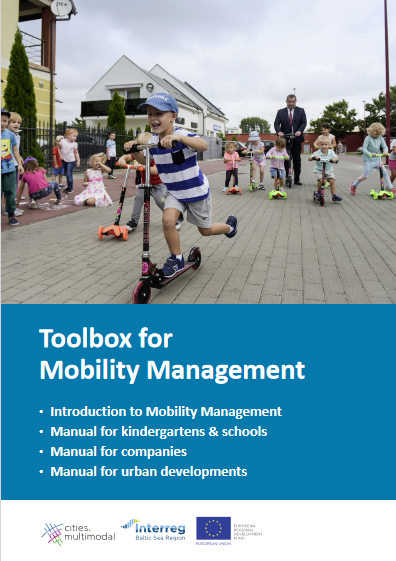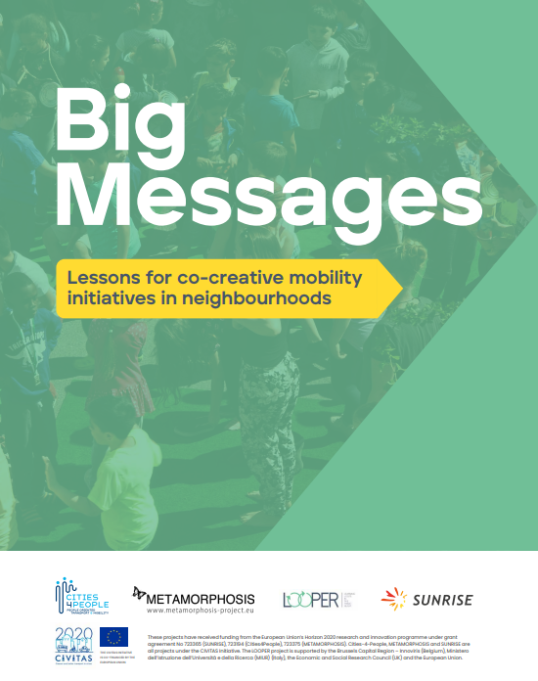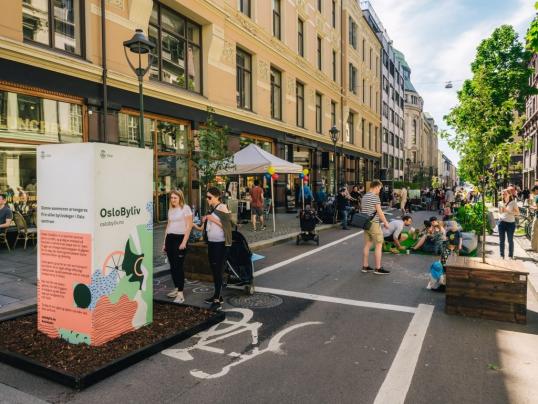- Topic
- Mobility management
- Country
- Europe-wide
- Resource type
- Case study
First published on 14 December 2021.
How do we ensure that an increasing urban population does not translate into more traffic, congestion and pollution in European cities? Mobility management offers a solution to this issue. Indeed, with its ‘soft approach’, mobility management is highly adaptable in promoting sustainable transport in different local circumstances. Because of this, it provides cities with good value for money and can complement infrastructure interventions, which ultimately reduces transport-related pollution and congestion.
Mobility management interventions have already been implemented successfully in several cities across Europe. This case study provides a comprehensive overview of the concept of mobility management, presents the relevant guidelines and tools available to urban planners and mobility practitioners, and highlights some prominent examples of mobility management actions that have been implemented across Europe.
Context
In Europe, around 71% of the total population lives in urban areas and it is estimated that this number will continue to increase in the coming years. As more and more residents congregate in cities, it is necessary to find ways for them to move around in a sustainable way. Mobility management aims to influence transport demand by offering services with the final objective of changing participants’ mobility behaviour.
But what is mobility management exactly?
Mobility management encompasses information and promotional measures, organisation and coordination measures, education and training measures, site-based measures, telecommunications and flexible time organisation, as well as some supportive and integrating actions. In practice, in a city where mobility management is implemented, one could move around using widely available shared transport systems (such as cars or bikes) and consult the local mobility centre to plan a leisure trip using public transport. In addition, employers could pay for their employees to use public transport to and from the office to discourage them from commuting in a car.
These are all ‘soft’ measures which are often implemented as a bundle. They not only have an impact on the ways in which people move around, but also more broadly on the liveability of urban spaces.
Mobility management is also considered to be a demand-side measure, whereas building new infrastructure, such as roads and bike lanes, is a supply-side measure. Nonetheless, infrastructure measures could support mobility management actions. Likewise, while mobility management does not normally include traffic system management, certain elements of traffic management (that is, those that aim to influence attitudes and transport demand away from car use, for instance by providing real-time information on train departure times) can be considered to be mobility management. Finally, mobility management also includes the use of legislation, and pricing incentives and disincentives.
A Sustainable Urban Mobility Plan (SUMP) is a strategic and essential planning tool for an urban area looking to move towards more sustainable and resident-friendly mobility systems. It defines a set of interrelated measures designed to satisfy the mobility needs of people and businesses at the local and regional level today and tomorrow, encouraging a shift towards more sustainable transport modes and supporting the integration and balanced development of all modes. Authorities developing a SUMP should consider the role that mobility management initiatives can play within their wider strategy while selecting the measures to consider.
This case study illustrates different approaches to mobility management. It presents guidelines and tools that can be applied by urban mobility practitioners, policy makers, school management, and both public and private employers who wish to implement mobility management measures in their jurisdictions. It also provides real-life evidence of these measures through various good practice city examples.
In action
Several guidelines have been produced on mobility management in the EU. A very relevant and interesting one is cities.multimodal’s Toolbox for Mobility Management, which includes information for various target groups seeking to implement mobility management activities in their institutions.
The EU co-funded project cities.multimodal – urban transport system in transition towards low carbon mobility (2017–2021) brought together cities, NGOs, universities and other expert partners to facilitate the use of sustainable mobility solutions for citizens in the Baltic Sea Region. Within this project, partner cities developed and applied contemporary sustainable urban mobility approaches, including mobility management concepts which were developed with and for various stakeholder groups. As such, the knowledge gained, and activities implemented within these projects may be applied to other cities.
As such, the Toolbox for Mobility Management provides an overview of general approaches to and basic tools for mobility management, before providing tailored manuals for the three key stakeholder groups (nursey schools, schools, companies and urban developments). Each manual outlines the need for action as well as opportunities. For example, for nurseries and schools, benefits of introducing mobility management include improved health through encouraging active mobility, and associated reductions in emissions from exhaust emissions, lower disturbance and stress levels through traffic noise, and more space for green areas.
General tips for implementation are provided, followed by suggestions for activities. Within the manual for companies, tips include involving motivated individuals as representatives, working with experienced external experts, and creating incentives such as days off and tax deductions to adjust employee’s travel behaviours. Suggested activities from the manual for urban developments include developing a multimodal city quarter, as implemented in Rostock in Germany. This concept provides concrete measures and advice on how to create a car-reduced quarter and specifies which sustainable mobility options will be integrated and how. The cities.multimodal’s Planners Guide to Sustainable Urban Mobility Planning also discusses and advices on testing new and innovative ways to involve citizens (and therefore help change behaviour) in mobility planning at the local level.
There are also many other tools that can be used to assist with the implementation of mobility management measures. Some of these include:
- Big Messages brochure
The Big Messages brochure discusses important lessons on the co-creation of sustainable urban mobility measures. Co-creation is an effective way of involving target groups in the development of mobility management measures, allowing them to provide insight and involving them in the sustainable mobility planning process, therefore creating demand led mobility solutions. The brochure captures the lessons learnt in four Horizon 2020 projects, with three of these being funded under the topic ‘new ways of supporting development and implementation of neighbourhood-level and urban-district-level transport innovations’ (Cities-4-People, Metamorphosis( and SUNRISE). This approach focuses on bringing together different societal representatives (typically including public administrators and residents) around matters of shared concern and is increasingly being applied to make governance more democratic, fair and inclusive. It starts from the idea that everyone has expert knowledge and experience in their own life, which is why co-creation is so relevant to developing neighbourhood mobility measures.
- SUMBA – Commuting Master Plan Template
The SUMBA project created a tool to support cities in creating a strategic approach to changing commuter habits and attitudes towards more sustainable and intermodal patterns. The aim of the document is to provide guidance and tips for compiling commuting master plans in urban regions, and to give recommendations on the aspects to include. It also provides recommendations for possible solutions to the key challenges. Due to administrative borders and institutional ‘silos’, many urban areas face challenges related to changes in travel demand that cannot be solved within a single municipality or by a single public authority. Commuting master plans, and planning for multimodal and sustainable regional mobility, helps to tackle these challenges. This tool provides the framework for local areas to effectively implement mobility management solutions by helping cities to implement a range of sustainable and intermodal transportation options for commuting, meeting individual needs in a strategic manner.
- SUMBA – Guidance on transport modelling and data collection
The SUMBA project also developed a guidance document that discussed the state-of-the-art transport modelling approaches and assessment tools, as well as the required data and possible data sources. Gathering empirical evidence through modelling is useful and relevant for various stakeholders e.g. for local decision-makers, employers and schools to choose and coordinate incentives towards the sustainable mode choices, and for operators to refine strategies and to optimise their service offerings. In the past, the most commonly chosen solution for coping with increasing traffic was to build new road infrastructure. However, modelling traffic measures and their secondary effects uses a more ‘soft’ approach, and can help decision makers select more efficient measures, integrate active transport modes, as well as foster intramodality in their local transport system based on demand led solutions. The most modern transport modelling concepts, approaches and techniques are introduced, as well as the software solutions that are available on the market. The document describes and compares not only major commercial applications, but also open-source solutions. Steps to build a model are also presented, including the respective data requirements. Different data sources are also described, including the steps needed to validate and manage the quality of the data. For those cities and regions that lack necessary data, ways of deriving missing data are presented and discussed in detail.
- SUITS – Capacity Building Toolbox
The SUITS project, one of three EU CIVITAS 2020 projects, aims to improve the capacity of local authorities and transport practitioners, and then to transfer this knowledge to smaller cities to increase their resilience to change during the implementation of sustainable urban mobility measures. The project developed a ‘capacity building program’ and toolbox consisting of learning materials dedicated to decision makers and planners in small and medium-sized cities to give them more responsibility in the planning process and help them understand how their local area can benefit. The programme aimed to fill the gaps in knowledge related to planning and financing sustainable urban mobility and the deployment of innovative mobility technologies. The material is available in the form of webinar recordings, online documents, case studies, good practices and different tools. The information and communication tools provided include identifying city needs and problems related to mobility (in all transport modes) and choosing the most relevant measures to help, therefore creating demand led mobility solutions. It can therefore increase the capacity of decision makers to effectively develop and implement strategies, policies, technologies, practices, procedures, tools, measures and intelligent transport systems in place that recognize the sustainable and intermodal end-to-end travel experiences of different local users.
Results
By following the guidelines and implementing the different tools outlined above, mobility management actions have been implemented differently in several cities across Europe, highlighting each city’s location-driven, demand-side approach.
In March 2021, Romania’s Ministry for Environment, Waters and Forests launched a nationwide campaign to promote the use of alternative transport to reduce pollution and carbon emissions. The campaign aimed to do this by encouraging people to give up travel by personal car on Fridays, particularly in cities, with the intention of having at least one in four employees by the end of the year coming to work on foot, by bicycle or by public transport. As cities started joining the ‘Green Friday’ campaign, the mayor of Cluj-Napoca, a city in northwestern Romania, highlighted other measures that the city was taking to foster the use of alternative transport. These included creating new bike lanes to connect neighbourhoods, having dedicated public transport lanes, and purchasing electric buses and trams.
Moreover, in France, the Île-de-France region has signed a charter to reduce commuting on public transport during peak hours by encouraging employees to work from home on some days, staggering working hours throughout day and promoting cycling, among other measures.
Additionally, the city of Toulouse has decided to test several mobility measures through the COMMUTE project to ensure that its rapid expansion will go hand in hand with sustainable urban mobility. These actions include:
- establishing an innovative mode of co-creation and cooperation between the service provider’s partners and stakeholders to ensure shared implementation;
- a digital platform dedicated to urban mobility that measures the impacts of the experiments implemented and also serves as a decision-making tool for mobility stakeholders based on data collected in real time;
- introducing innovative actions that contribute to traffic reduction, such as encouraging flexible and remote working, car sharing and autonomous shuttles.
Finally, in 2019, the city of Lahti in Finland launched a Personal Carbon Trading scheme through the CitiCAP project, in an overarching effort to make the urban area more environmentally friendly. The scheme works through an app that automatically tracks the means of transport used by each user. This enables them to see the carbon footprint generated by their transport use and track changes in their emission patterns as they adapt to more sustainable transport use. The app then rewards users with virtual currency if, instead of using the car, they decide to walk or ride a bike. The virtual currency can be used to purchase public transport tickets, and access sports halls and local swimming pools, etc.
The cases outlined above indicate that mobility management actions start to be implemented around Europe, in a location- and demand-driven manner. These measures are often implemented in a bundle in an effort to boost their effectiveness.
Challenges, opportunities and transferability
Mobility management is clearly a flexible, demand-driven approach to supporting sustainable urban transport. Therefore, it is highly adaptable to different contexts and circumstances. Where mobility management measures have been implemented successfully, it is possible to draw some useful lessons learnt.
Firstly, it is important to engage stakeholders early on to gain buy-in for the measures to be implemented. For instance, the Norwegian capital city, Oslo, implemented a car-free ‘Livability Programme’ to reclaim street and parking spaces in exchange for greener and more inclusive spaces. While the initial plan was to create a car-free zone in the city centre, this proposal faced significant opposition, particularly from businesses. The city thus decided to take a three-phase approach, aiming to have the least possible number of cars in the centre. Importantly, continued stakeholder engagement was essential to the success of the project. Indeed, planners needed to make sure that they were engaging residents and stakeholders and, consequently, implementing mobility management actions in a context-driven manner. For example, in the case of Oslo, stakeholders were invited to provide their inputs at different stages of the project. The stakeholders included representatives of leisure clubs, cultural groups, businesses, restaurants, young and senior residents, and people living, visiting and working in the centre.
Secondly, information communication technologies can support mobility management and provide useful and reliable data. Indeed, accurate data is vital for the effective implementation, monitoring and evaluation of measures. For example, the city of Belgrade in Serbia made great efforts to implement its SUMP, despite its lack of quality infrastructure for sustainable and active transport. Among the actions included in the SUMP, the city plans to establish a comprehensive mobility-as-a-service system that can offer personalised multimodal mobility packages to users. This could not only help users in navigating multimodality, but also planners who could gather important data for programme monitoring and evaluation.
Finally, for mobility management measures to be effective, they should be limited in their geographic scope, be context specific and be demand driven. This allows for the development of tailor-made solutions which, in turn, are more likely to be successful. While this is a common thread throughout all of the actions outlined in this case study, a clear example comes from the Metropolitan Region of Amsterdam in the Netherlands where employers were seeking ways to improve mobility related to their businesses and employees. To this end, in 2015, a network called Breikers was created by two industry interest and business groups to support employers in the region during the transition to smart and sustainable transport (including for logistics). Since the start of Breikers, over 250 employers have joined the network to receive tailored advice and support. This has resulted in lasting changes for employers and employees alike, making work commutes more sustainable, according to each business’s needs. This case clearly highlights the importance of taking a demand-driven and participatory approach to mobility management to ensure that change lasts beyond the period of intervention.
The Tested and effective: Mobility solutions from CIVITAS Living Lab projects document supports these findings, presenting results and lessons learnt from testing 175 sustainable mobility measures across 16 cities in Europe between 2016 and 2020. The report highlights several reflections from project coordinators, including, the importance of engaging with local employers early on, the value of limiting the intricacy and geographical scope of interventions, and the importance of applying a combination of measures – rather than single, specific actions – as being the most effective approach to achieving local objectives.
In Depth
Tools:
- Cities.multimodal toolbox (https://www.eltis.org/sites/default/files/trainingmaterials/tr_toolbox_layout_v19.pdf)
- Big Messages brochure: Lessons for co-creative mobility initiatives in neighbourhoods (https://www.eltis.org/resources/tools/big-messages-brochure-lessons-co-creative-mobility-initiatives-neighbourhoods) (Feb 2021)
- SUMBA Commuting Master Plan Template (Aug 2020)/guidance for modelling and data collection (Aug 2020)/compendium of implemented solutions/benchmarking scheme for intermodal commuting (https://www.eltis.org/resources/tools/sumba-commuting-master-plan-template) (https://www.eltis.org/resources/tools/guidance-transport-modelling-and-transport-data-collection-intermodality) (https://sumba.eu/en/articles/tools-guidance(link is external))
- SUITS Capacity Building Toolbox (https://www.eltis.org/resources/tools/suits-capacity-building-toolbox) (Aug 2020)
Case studies:
- ‘Work Smart, Travel Smart' – Mobility management in Amsterdam (https://www.eltis.org/resources/case-studies/work-smart-travel-smart-mobility-management-amsterdam) (June 2021)
- ‘Belgrade, finalist of the 9th SUMP Award – challenging reality meets ambitious targets’ (https://www.eltis.org/resources/case-studies/belgrade-finalist-9th-sump-award-challenging-reality-meets-ambitious-targets) (May 2021)
- ‘Oslo – Promoting Active Transport Modes’ (https://www.eltis.org/resources/case-studies/oslo-promoting-active-transport-modes) (Feb 2021)
News:
- New CIVITAS publication reveals tested and effective sustainable mobility solutions (https://www.eltis.org/in-brief/news/new-civitas-publication-reveals-tested-and-effective-sustainable-mobility-solutions) (June 2021)
- Marijampolė initiates Sustainable Mobility Plan (https://www.eltis.org/in-brief/news/marijampole-initiates-sustainable-mobility-plan) (April 2021)
- Romania launches a national Green Friday campaign to promote the use of alternative transport (https://www.eltis.org/in-brief/news/romania-launches-national-green-friday-campaign-promote-use-alternative-transport) (April 2021)
- Baden-Württemberg supports municipalities in hiring new employees for sustainable mobility (https://www.eltis.org/in-brief/news/baden-wurttemberg-supports-municipalities-hiring-new-employees-sustainable-mobility) (Mar 2021)
- Report on 'Mobility as a Service (MaaS): A digital roadmap for public transport authorities' (https://www.eltis.org/in-brief/news/report-mobility-service-maas-digital-roadmap-public-transport-authorities) (Jan 2021)
- Parking management video clips: examples of tried and tested solutions (https://www.eltis.org/in-brief/news/parking-management-video-clips-examples-tried-and-tested-solutions) (Oct 2020)
- Valencia creates 1,060 smart parking spaces in a pilot scheme (https://www.eltis.org/in-brief/news/valencia-creates-1060-smart-parking-spaces-pilot-scheme) (Oct 2020)
- The City of Lahti unveils a personal carbon trading scheme (https://www.eltis.org/in-brief/news/city-lahti-unveils-personal-carbon-trading-scheme-0) (July 2020)
- The UIA projects COMMUTE in Toulouse: https://www.uia-initiative.eu/fr/uia-cities/toulouse-metropole
- Citycap in Lahti https://www.uia-initiative.eu/fr/uia-cities/lahti
- Charter approach in Ile de France: https://www.polisnetwork.eu/news/ile-de-france-region-signs-charter-to-reduce-commuting-during-peak-hours/
Photo Credits:
Kzenon © / Shutterstock.com - no permission to re-use image(s) without separate licence from Shutterstock
CitiCAP Project
Oslo Livability Programme





